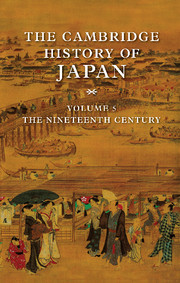Book contents
- Frontmatter
- Introduction
- 1 Japan in the early nineteenth century
- 2 The Tempō crisis
- 3 Late Tokugawa culture and thought
- 4 The foreign threat and the opening of the ports
- 5 The Meiji Restoration
- 6 Opposition movements in early Meiji, 1868–1885
- 7 Japan's turn to the west
- 8 Social change
- 9 Economic change in the nineteenth century
- 10 Meiji political institutions
- 11 Meiji conservatism
- 12 Japan's drive to great-power status
- Works Cited
- Index
- References
2 - The Tempō crisis
Published online by Cambridge University Press: 28 March 2008
- Frontmatter
- Introduction
- 1 Japan in the early nineteenth century
- 2 The Tempō crisis
- 3 Late Tokugawa culture and thought
- 4 The foreign threat and the opening of the ports
- 5 The Meiji Restoration
- 6 Opposition movements in early Meiji, 1868–1885
- 7 Japan's turn to the west
- 8 Social change
- 9 Economic change in the nineteenth century
- 10 Meiji political institutions
- 11 Meiji conservatism
- 12 Japan's drive to great-power status
- Works Cited
- Index
- References
Summary
On the sixteenth day of the twelfth month of the year 1830, Japan entered a new era. By coincidence, that same afternoon, in a cottage not far from Shibuya, Matsuzaki Kōdō, a Confucian scholar, observed a flock of white cranes, “skimming over the hill” (as he wrote in his diary) from the direction of Aoyama. He recorded their appearance the following morning, too, “wheeling northwards in the sunlight,” his unmistakable delight suggesting just how reassuring it was that these stately and auspicious birds should show themselves at such a time. No era could have had so propitious an opening. Matsuzaki was equally happy with the new era name itself – “Tempō,” or Heavenly Protection. It was well known that selecting era names was a delicate business, for the least carelessness – the use of Chinese characters already encumbered with unhappy associations, or those inviting ominous paranomasia – could well prejudice the prosperity of the entire nation. In this case, there seemed nothing to fear. The two characters for Tempō, as the elderly scholar construed them, paid tribute to two previous eras, the first being the Tenna era (1681–83) and the second, the Kyōhō era (1716–35). Matsuzaki did not need to remind himself that for scholars at least, both periods carried favorable overtones, suggestive of new hope, of depravity reformed, and of righteousness restored. This, too, augured well for the future.
- Type
- Chapter
- Information
- The Cambridge History of Japan , pp. 116 - 167Publisher: Cambridge University PressPrint publication year: 1989
References
- 21
- Cited by

